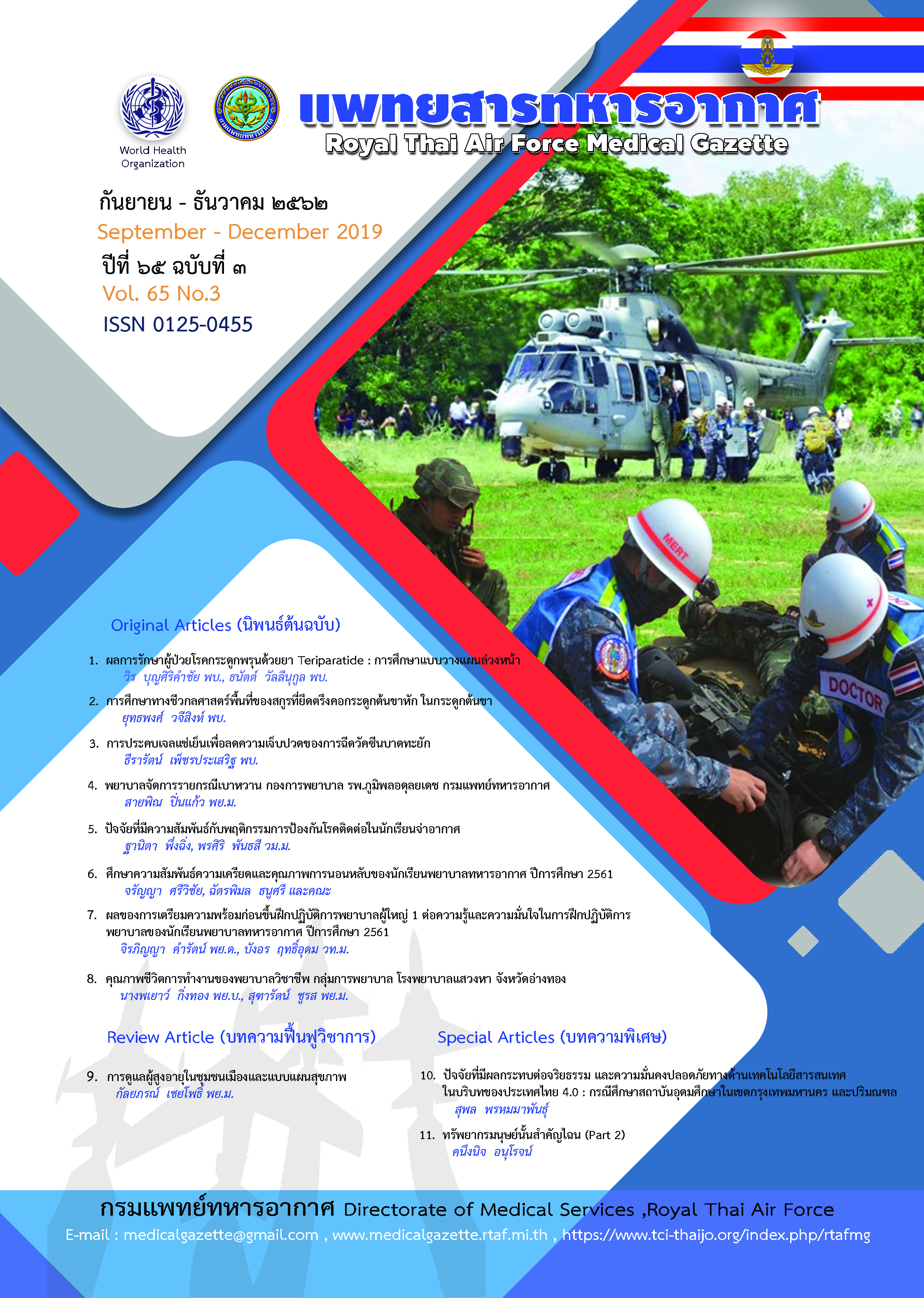A Biomechanical Study Area of Cannulated Screw Fixation for Femoral Neck Fracture in Cadaveric
Main Article Content
Abstract
Objective : To study the area of cannulated screw in femoral neck whether it will cause the biomechanical effect to femoral neck in terms of strength and stability or not and to consider the procedure to position the screws with multiple screw fixation method to gain appropriate placement and stable strength according to principle of biomechanics.
Material and methods : 24 cadaveric femurs were brought to do an osteotomy at the center of the femoral neck with 60 degree to the horizontal (Pauwel II) by using Image J photo analyzing program to calculate the cross-sectional area of femoral neck and defined screw placement in the form of an inverted triangle in three different positions by dividing the screw area of femoral neck in 3 different areas which were the area A, B and C. Reduction and fixation done with Cannulated screw No. 6.0. The femur was tested with mechanical test (Instron series IX) to analyze Axial stiffness, Axial load to failure, Axial Failure Displacement and Axial failure energy. This data was collected and interpreted.
Results : Femoral neck fracture fixation by using a multiple screw fixation method with cannulated screw, was divided screw area in femoral neck into 3 areas which are area A (4.19 cm.2), area B (2.64 cm.2) and area C (1.35 cm.2). It found that area A which was the most covered areas in femur had a better biomechanical effect than area B and C which were less covered area in femur, respectively. Biomechanical effect in area B was better than area C in Axial stiffness, Axial load to failure, Axial failure displacement and Axial failure energy and there was a statistically significant difference.
Conclusion : The result of femoral neck fracture fixation by using a multiple screw fixation method with a cannulated screw which its placement was in the form of an inverted triangle showed that the more screw placement covers the femoral neck area the more it causes a biomechanical effect and the most stability after the operation.
Article Details

This work is licensed under a Creative Commons Attribution-NonCommercial-NoDerivatives 4.0 International License.
บทความที่ได้รับการตีพิมพฺเป็นลิขสิทธิ์ของวารสาร
References
operation of femoral neck fracture. Zhonghua Wai Ke Za Zhi. 2010 Jul;48(14):1101-5.
2. Huang G, Ji Y, Lai W, Tang X, Wu G, Tian P, Xiang Z. Percutaneous screw fixation for the treatment of pelvic
fractures under c-arm fluoroscopy. China journal of orthopaedics and traumatology. 2014 July;27(4):345–8.
3. Mutlu H, Mutlu S. Cannulated versus Non-Cannulated Cancellous screw fixation for Femoral neck fractures: A
synthetic bone Biomechanical study. Journal of Orthopaedic Surgery. 2015 Aug;23(2):271.
4. Parker M, Stockton G. Internal fixation implants for intracapsular proximal femoral fractures in adults. The
Cochrane database of systematic reviews. 2001 Nov;18(3):319-25.
5. Walker E, Mukherjee D, Ogden A, Sadasivan K, Albright J. A biomechanical study of simulated femoral neck
fracture fixation by cannulated screws: Effects of placement angle and number of screws. American journal of
orthopedics (Belle Mead, N.J.). 2008 Feb;36(12):680-4.
6. Baumgaertner, Solberg B. Awareness of tip-apex distance reduces failure of fixation of trochanteric fractures of the hip. The Journal of bone and joint surgery. British volume. 1997 Dec;79(6):969-71.
7. Freitas A, Lula WF, Oliveira JS de, Maciel RA, Souto DR de M, Godinho PF. Analysis of mechanical strength to
fixing the femoral neck fracture in synthetic bone type Asnis. Acta Ortopedica Brasileira. 2014 July;22(4):206-9.
8. DeAngelis JP. Biomechanics of Femoral neck fracture fixation. Techniques in Orthopaedics. 2010 Sep;25(3):160-3.
9. Holmes CA, Edwards WT, Myers ER, Lewallen DG, White AA, Hayes WC. Biomechanics of pin and screw
fixation of Femoral neck fractures. Journal of Orthopaedic Trauma. 1993 June; 7(3):242-7.
10. Walker E, Mukherjee D, Ogden A, Sadasivan K, Albright J. A biomechanical study of simulated femoral neck
fracture fixation by cannulated screws: Effects of placement angle and number of screws. American journal of
orthopedics (Belle Mead, N.J.). 2008 Feb 12;36(12):680-4.
11. Soylemez M, Ozkan K, T?rkmen I, Sahin A, Yildiz Y, Erturk S. A biomechanical comparison of proximal femoral
nails and locking proximal anatomic femoral plates in femoral fracture fixation A study on synthetic bones. Indian
Journal of Orthopaedics. 2015;49(3):347.
12. Mizrahi J, Hurlin RS, Taylor JK, Solomon L. Investigation of load transfer and optimum pin configuration in the
internal fixation, by Muller screws, of fractured femoral necks. Medical & Biological Engineering & Computing.
1980 May;18(3):319-25.
13. Booth K, Donaldson T, Dai Q. Femoral neck fracture fixation: A biomechanical study of two cannulated screw
placement techniques. Orthopedics. 1998 Dec 9;21(11):1173-6.
14. Selvan VT, Oakley MJ, Rangan A, Al-Lami MK. Optimum configuration of cannulated hip screws for the fixation
of intracapsular hip fractures: A biomechanical study. Injury. 2004 Feb;35(2):136-41.
15. Mei J, Liu S, Jia G, Cui X, Jiang C, Ou Y. Finite element analysis of the effect of cannulated screw placement
and drilling frequency on femoral neck fracture fixation. Injury. 2014 Dec;45(12):2045-50.
16. Samsami S, Saberi S, Sadighi S, Rouhi G. Comparison of Three fixation methods for Femoral neck fracture in
young adults: Experimental and numerical investigations. Journal of Medical and Biological Engineering. 2015
Oct; 35(5):566-79.
17. Zdero R, Keast-Butler O, Schemitsch EH. A Biomechanical comparison of Two triple-screw methods for Femoral
neck fracture fixation in a synthetic bone model. The Journal of Trauma: Injury, Infection, and Critical Care. 2010
Dec;69(6):1537-44.
18. E W, Dp M, Ogden A ;, Mayeux R, Kk S, Albright; Femoral neck fracture fixation by cannulated screws.
Orthopedic research society; 1994 May;65(6):637-12.


